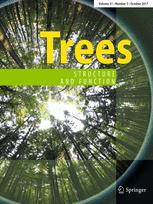View Item
- xmlui.general.dspace_homeCentros Regionales y EEAsCentro Regional Patagonia NorteEEA BarilocheArtículos científicosxmlui.ArtifactBrowser.ItemViewer.trail
- DSpace Home
- Centros Regionales y EEAs
- Centro Regional Patagonia Norte
- EEA Bariloche
- Artículos científicos
- View Item
Morpho-physiological responses of Nothofagus obliqua to light intensity and water status, with focus on primary growth dynamics
Abstract
Primary growth affects plant plasticity by influencing the number, spatial arrangement and time of differentiation of the leaves. For Nothofagus obliqua, we evaluated if primary shoot growth dynamics determines short-term responses to environmental conditions, and intra-individual variations in such responses. Before bud-break, saplings were located in experimental conditions, combining two light treatments with two water supply treatments. For each
[ver mas...]
Primary growth affects plant plasticity by influencing the number, spatial arrangement and time of differentiation of the leaves. For Nothofagus obliqua, we evaluated if primary shoot growth dynamics determines short-term responses to environmental conditions, and intra-individual variations in such responses. Before bud-break, saplings were located in experimental conditions, combining two light treatments with two water supply treatments. For each individual, morphology, relative extension rate (RER), and relative leaf chlorophyll content (SPAD units) were registered for the annual shoot derived from the most distal bud of two axis categories: the main axis (trunk) and a main branch. For trunk shoots, we analysed the net photosynthetic rate at saturating photosynthetic photon flux density (Psat) of proximal and distal leaves. Shaded trees had higher RER, longer and more slender shoots, longer internodes, and higher leaf chlorophyll content than unshaded trees. The number of nodes was affected by water condition in trunk shoots, and by light condition in main branch shoots. Full sunlight stimulated the development of a branch following the length and growth direction of its parent shoot (relay branch). Shade would have promoted the development of neoformed leaves. Under shade and low water availability, water use efficiency was higher in distal than proximal leaves. Under high sunlight and water availability, leaves of relay branches presented slightly higher Psat with higher water loss than both proximal preformed leaves and distal leaves under the other tested conditions. This study highlights the need of assessing intra-individual variations in shoot acclimation in relation to axis differentiation.
[Cerrar]

Author
Torres, Cristian Daniel;
Magnin, Amaru;
Varela, Santiago Agustin;
Stecconi, Marina;
Grosfeld, Javier Edgardo;
Puntieri, Javier G.;
Fuente
Trees. Structure and Function 32 (5) : 1301–1314 (Octubre 2018)
Date
2018-10
Editorial
Springer Nature
ISSN
1432-2285
Formato
pdf
Tipo de documento
artículo
Palabras Claves
Derechos de acceso
Restringido
 Excepto donde se diga explicitamente, este item se publica bajo la siguiente descripción: Creative Commons Attribution-NonCommercial-ShareAlike 2.5 Unported (CC BY-NC-SA 2.5)
Excepto donde se diga explicitamente, este item se publica bajo la siguiente descripción: Creative Commons Attribution-NonCommercial-ShareAlike 2.5 Unported (CC BY-NC-SA 2.5)

